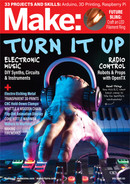
PROJECTS: Electro Etching Brass
clip it to a piece of steel about the same size as
your brass. Now that your two electrodes are
ready to go, fill your plastic container with warm,
salty water, about 1 part salt to 5 parts water. I
used a container intended for storing cereal.
Place the aquarium aerator in the middle,
which will keep the liquid moving and also help
separate the two electrodes.
Now place the electrodes into the solution, one
on either side of the aerator. The two electrodes
should not touch. You can use a clamp to hold one
or both to the side of the container (Figure
D
).
You don’t want to touch the bare metal once the
power is plugged in.
3. ETCH IT
Now plug in the aquarium pump and the 12V
power supply. As the reaction begins, you should
see bubbles start to form on the exposed metal
surfaces (Figure
E
).
I let each of my plaques etch for about 2 hours.
You could speed this up by substituting vinegar for
the water, but I didn’t want to make a big smell.
For safety, you shouldn’t leave your electro
etching rig unattended while it’s on. Also, this
setup can create small amounts of harmful gas,
depending on which metals you’re working with,
so do this in a well-ventilated area.
So, what’s happening here? Electrical etching
D
E
F
G H
98 makezine.com
M85_096-99_ElectroEtching_F1.indd 98M85_096-99_ElectroEtching_F1.indd 98 4/9/23 12:54 PM4/9/23 12:54 PM
..................Content has been hidden....................
You can't read the all page of ebook, please click here login for view all page.
